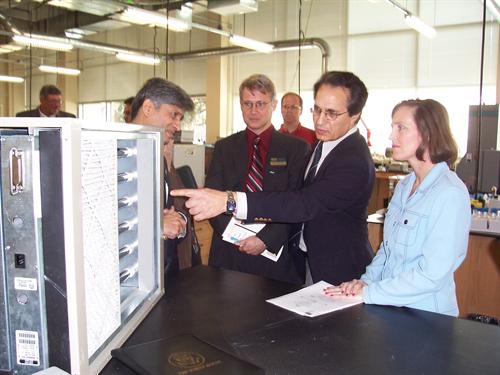Article
Castor tours Clean Energy Research CenterSeán Kinane - WMNF News Radio
Tampa,
December 10, 2007
|
Agustina Guerrero
((813)871-2817)
Tags:
Climate Crisis
Last week, the U.S. House of Representatives passed a landmark energy bill that could increase vehicle fuel efficiency standards and require that 15 percent of electricity be generated from renewable sources by 2020. But the Senate is expected to pass a version of the bill that is much weaker on renewable energy standards.
U.S. Rep. Kathy Castor voted for the energy bill. Today she visited the Clean Energy Research Center on the University of South Florida’s Tampa campus to learn about their renewable energy research.
WMNF Evening News Monday Listen to this entire show:
Last week, the U.S. House of Representatives passed a landmark energy bill that could increase vehicle fuel efficiency standards and require that 15 percent of electricity be generated from renewable sources by 2020. But the Senate is expected to pass a version of the bill that is much weaker on renewable energy standards. U.S. Rep. Kathy Castor voted for the energy bill. Today she visited the Clean Energy Research Center on the University of South Florida’s Tampa campus to learn about their renewable energy research. Castor toured the laboratory of Yogi Goswami, a professor of chemical engineering at USF and co-director of the Clean Energy Research Center. She saw prototypes of solar-powered devises that disinfect both air and water by removing microbes and toxins using titanium dioxide. Goswami also demonstrated equipment that uses solar power to produce electricity for a home at the same time it cools it. “The way it will work – you would have solar collectors on your roof and you may have a system outside your house just like your central air conditioning system, but that system will be running on sunlight and will be producing the power that you need and at the same time produce cooling.” Goswami hopes this technology will go commercial in two to three years; once full production begins, the cost to consumers could be about $3,000 per kilowatt. “You could design a system that for example produces 5 kilowatts of power. That power may be enough for some houses and may not be enough for some other houses. So you will have to design houses where you first reduce the energy consumption, make them as energy efficient as you can, and then you go for solar energy to provide part of the power and cooling full-house.” Renewable energy innovations like these could benefit from the House version of the energy bill. But Castor said there is a danger that the Senate will remove some of the provisions that were passed in the House version. “The commitment to better fuel economy, better gas mileage for our cars will stay in the bill, I predict. All of the other efficiency standards for appliances will stay in the bill. Grants to our great universities like the University of South Florida Clean Energy Research Center will stay in the bill. They may backtrack on the requirement that we generate 15 percent of our energy in this country from renewable energy.” Phil Compton is the regional representative with the climate change campaign of the Sierra Club. He suggested that Floridians call Sen. Mel Martinez to recommend that the renewable energy standard be left in the Senate version of the energy bill. ACT Compton-Biomass.wav (38 sec) “Half the states in America have said, heck, we could do 20 or 30 percent by 2020, including Governor Crist here in Florida says we’ll do 20 percent. We need a national standard. A lot of the utility companies are opposing going to a clean source of energy in the future. Utility companies like Tampa Electric who are heavily invested in coal. We can substitute as much as 15 percent of coal in any coal-burning plant with biomass and provide cleaner energy that way without making any changes to the equipment or any changes to the technology that we’re using.” Castor predicts the Energy Bill will become law, even if the Senate removes the renewable energy standards. “If they take that out, or reduce the percentage, we will probably still pass the bill, and then look for coming back with tougher renewable energy standards after the next election because I think folks here in the Tampa Bay area and across the country are ready for this fundamental shift in energy policy.” The House version of the bill funds clean energy research by taking away huge tax breaks that oil companies have been getting for years. But the Sierra Club’s Compton said the Senate version might give these subsidies back to big oil. “Well, they’re being redirected in effect towards subsidies for the type of research that’s going on here at USF. How do we move forward in the future the way the rest of the world is right now into developing clean renewable sources like wind, biomass and solar. This is the kind of research and support that we need. I don’t think that the oil companies need to have research and development assistance since the oil companies, as we all know, are the most profitable companies in the world. They made more money last year than anybody has ever made. But the little solar energy companies and the research centers like here at USF definitely need that support from our taxpayers to move to a cleaner future.” For years, USF has used solar panels to charge some electric vehicles, but the Clean Energy Research Center’s Goswami admits that the campus could do much better when it comes to solar energy. “Buildings are part of what the state does and I’m hoping that in the future when we plan buildings or construct new buildings because the cost of utilities or electricity will be so expensive, hopefully we will build them in a way that they use less energy to begin with and then part of that energy comes from solar energy.” |


